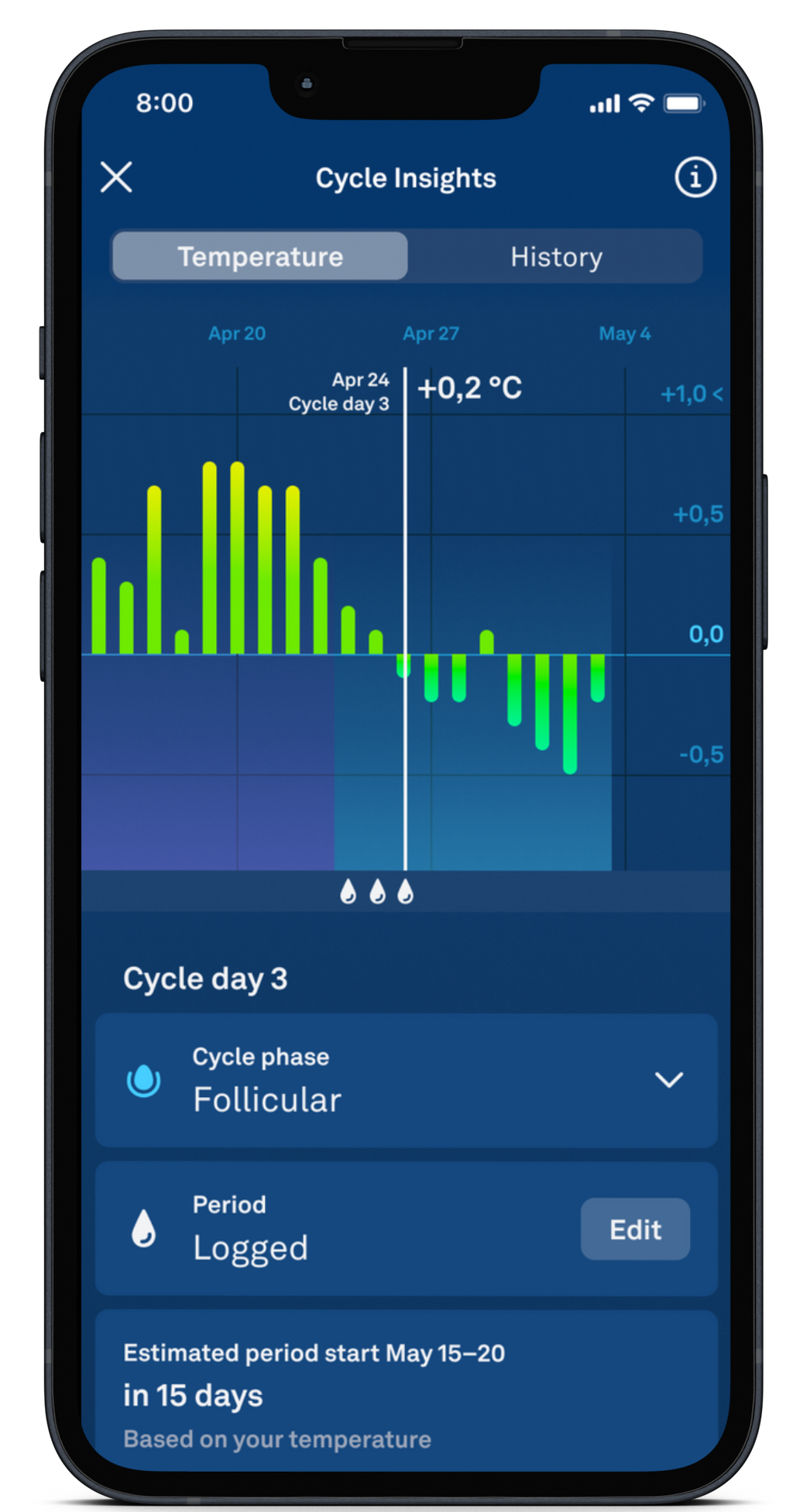Oura aims to be your daily health companion, in all phases of your health journey. For people who menstruate, the Cycle Insights feature provides detailed data and insights, including cycle phases, cycle stats, fertility signals, educational resources, and more, helping to deepen your body literacy and gain clarity into your reproductive health.
RELATED: Oura’s Commitment to Prioritizing Women’s Health
Accuracy Updates
- More than twice as accurate for all members
- Nearly three times as accurate for members in perimenopause
- Twice as accurate for members with irregular cycles
New to Cycle Insights: Fertile Window
In October 2024, we introduced a new feature to Cycle Insights: Fertile Window. You’ll now have a view of your estimated peak fertility, chance of conception, predicted ovulation day, and when ovulation has been detected.
The Fertile Window feature uses two algorithms to predict and detect your most fertile days based on your past cycles and physiological data, including heart rate, heart rate variability, temperature trends, and respiratory rate.
LEARN MORE: What Is the Fertile Window?
Note: Fertile Window is not intended to be used a method of birth control. For a hormone-free option for birth control, check out Natural Cycles, powered by Oura.
The predictions and insights provided are based on general patterns and algorithms that analyze your body’s signals, but they cannot account for every individual variation or unexpected cycle change.
Cycle Tracking

Using biomarkers like body temperature trends, Cycle Insights will show you which phase of the menstrual cycle you’re in. You’ll also receive daily insights on how your cycle impacts your entire body.
While your Readiness Score shows you how primed you are for the day ahead and your Sleep Score answers how you slept the night before, Cycle Insights addresses the question: Is there anything new I might notice about my body in this cycle phase?
For instance, you may notice that taking a midday nap helps to alleviate your PMS symptoms during the late-luteal phase, or that strength training in your follicular phase helps you sleep more soundly.
Note: that you’ll need at least 60 nights of Oura data to establish your personal body temperature baseline in order to see your cycle phases.
READ MORE: Cycle Syncing 101: Tips to Support Your Sleep, Mood, and Energy Throughout Your Cycle
Cycle Stats
In May 2024, we released an updated version of Cycle Insights after listening to member feedback. Now, the feature includes Cycle stats, which show your typical cycle length, cycle variability, and period length. These are each based on the medians of the cycles you’ve logged over the past six months.
- Cycle length is the length of time between the first day of your period and the day before your next period begins. Cycles that last between 21 and 35 days are considered regular, according to the American College of Obstetricians and Gynecologists (ACOG).
- Cycle variability refers to differences in the length of your cycles over time. Cycle variability of +/- three days or less is considered regular.
- Period length is the time between your first and last day of menstrual bleeding. Periods that last between two and eight days are considered regular.
Additionally, we’ve made it easier to log your period directly within the Cycle Insights card. With just a few taps, you can record or edit your menstrual days and log multiple days of your period at the same time.
Finally, in the Resources section, you’ll find educational blogs and other resources that will support you in deepening your body literacy.
Cycle Insights Report
Often considered a “fifth vital sign,” the menstrual cycle is often a topic of conversation when women meet with their doctors.
However, many women find it difficult to recall exactly when their last period started, or how long their cycle or period usually lasts. Unfortunately, this can sometimes lead to gaslighting or uncomfortable questions from a healthcare provider.
The Cycle Insights report, co-created with top OBGYNs, takes out the guesswork and provides objective, solid data that women can share with their healthcare providers.
What’s included in the Cycle Insights report?
- Typical cycle length (including specific dates for the last 6 cycles)
- Typical period length (including specific dates for the last 6 cycles)
- Cycle variability
- Body temperature trends over the last 90 days
- Top symptom tags associated with each cycle phase
How to download the Cycle Insights report:
Find your Cycle Insights report in two locations in the Oura App:
- Access it directly from the Cycle Insights feature through the link, “Create a shareable report,” found at below your “Cycle stats”
- Access it from the Menu > Reports > Shareable Reports.
Read the Oura Privacy Policy for more information.
3 Benefits of Using Cycle Insights
Knowing which phase of your cycle you’re in gives you clarity into fluctuations in your mood, reproductive health status, and other symptoms. Oura’s Cycle Insights supports your body through these changes in order to help you thrive.
1. Support your reproductive health.
Monitoring your menstrual cycle over time can provide insights into your typical menstrual pattern – such as the regularity or length of your cycle.
Changes in the menstrual cycle can sometimes be indicative of underlying health conditions, hormonal imbalances, pregnancy, or menopause. Being able to spot abnormalities can prompt you to seek medical advice if needed, potentially aiding in the diagnosis and management of reproductive health issues.
2. Spot patterns in your symptoms.
Many individuals experience physical and emotional symptoms during different phases of their menstrual cycle, such as bloating, mood changes, or fatigue. Women with premenstrual syndrome (PMS) or premenstrual dysphoric disorder (PMDD) experience more noticeable physical and emotional changes, which can impact how they go about their day-to-day lives. By tracking your cycle, you can anticipate and prepare for these symptoms, and take appropriate self-care measures.
3. Deepen your overall body literacy.
If you’ve ever felt in the dark about your menstrual cycle, know you’re not alone. Research has found that more than half of women don’t know when their next menstruation will be, while 67% don’t know when ovulation happens during their cycle.
An enhanced understanding of your own menstrual cycle can empower you to feel more in tune with your body, empowering you to make informed decisions about your health and well-being.
RELATED: Busting the 14-Day Ovulation Myth
FAQs
Who can use Cycle Insights?
People who have a natural menstrual cycle will be able to use the feature since it relies on detecting the temperature changes driven by your hormonal cycle. To see your menstrual phases in Cycle Insights, log the start of your period, which signals the start of your follicular phase. Cycle Insights will not be applicable to those who are post-menopausal.
If you are using non-hormonal birth control, like Natural Cycles, you will be able to use Cycle Insights.
If you do not have a natural temperature cycle — whether due to menopause, hormonal birth control, or other factors — you will not be able to see follicular and luteal phases in Cycle Insights. However, you will still be able to log your last period and see period predictions.
How does Oura track my cycle and determine which phase I’m in?
Oura tracks changes in your body’s signals, and your menstrual cycle is a vital sign of your overall health. From heart rate variability (HRV) to body temperature and resting heart rate (RHR), Oura is constantly measuring how your body is doing. This information can be used to inform the algorithm where you are in your menstrual cycle.
The most important biosignal for menstrual cycle tracking is your body temperature trend.
- Follicular phase (including menstruation and ovulation): Once your period starts, your body temperature drops, and remains low throughout this phase. During ovulation, you may experience a slight increase in body temperature.
- Luteal phase: Once you have ovulated, your body temperature sharply increases, and continues to rise up until your period starts.
Note that you need at least two months’ worth of consistent temperature data recorded in the Oura App or personal body temperature to be used in predictions.
Why is my cycle phase “unknown”?
A number of issues could cause unknown cycle phases, including:
- Your initial 60 nights of data haven’t accumulated yet
- You haven’t worn your ring consistently while sleeping
- You haven’t synced your Oura App
- You haven’t been logging your periods
- Network error
- Lack of physiological patterns
If there is a lack of physiological patterns, this could be due to:
- A short-term factor that made it difficult to determine your cycle phase for this month, such as alcohol, sickness, medication, jet lag, stress, or a one-off anovulatory cycle.
- A long-term factor that consistently makes it difficult to determine your cycle phase, such as taking hormones, coming off of hormones in the past 6 months, pregnancy, persistent anovulatory cycles (you repeatedly do not ovulate every month), or coming off of hormones for 6+ months without menstruation.
If you persistently do not see cycle phases after troubleshooting the above potential issues, then you might want to discuss your cycle history and temperature graph with your doctor. It’s perfectly healthy to get a one-off anovulatory cycle where you do not ovulate that month, but a persistent lack of pattern in your temperature data every month could indicate an underlying issue.
How is typical cycle length calculated?
Your typical cycle length is the median length of your logged cycles over the past six months.
For example, let’s say that over the past six months, you logged cycles with the following lengths:
28 days; 28 days; 30 days; 32 days; 32 days; 33 days
The median of this sample would be the average of your middle two cycle lengths — 30 days and 32 days in this case — resulting in a typical cycle length of 31 days.
Please note: If you have less than six months of cycle data with Oura, your typical cycle length will be the median length of the cycles you’ve logged so far.
What if your cycle length is irregular?
Many factors can contribute to changes in cycle length and one irregular cycle is typically nothing to worry about. However, if you’re experiencing consistent irregularity in your cycle length (see the ACOG’s definition here), or have questions about your cycle in general, it’s a good idea to consult with your doctor.
RELATED: 7 Potential Reasons Why Your Menstrual Cycle Is Getting Shorter
How is cycle variability calculated?
Your cycle variability is the median difference in the length of your cycles over the past six months, divided by two.
For example, let’s say that over the past six months, you logged cycles with the following lengths:
28 days; 32 days; 31 days; 29 days; 33 days; 28 days
Moving from cycle to cycle, the differences in length would be four, one, two, four, and five days.
Since the median of this sample would be four days, your cycle variability would be +/- 2 days — four divided by two.
Please note: If you have less than six months of cycle data with Oura, your cycle variability will consider the median difference of the cycles you’ve logged so far.
What if your cycle variability is irregular?
Many factors can contribute to changes in cycle variability, and a single instance of irregular cycle variability is typically fine. However, if you’re experiencing consistent irregularity in your cycle length or have questions about your cycle in general, it’s a good idea to consult your doctor.
How is typical period length calculated?
Your typical period length is the median length of your logged periods over the past six months.
For example, let’s say that over the past six months, you logged periods with the following lengths:
8 days; 8 days; 7 days; 7 days; 6 days; 5 days
The median of this sample would be the average of the middle two period lengths — both 7 days in this case — resulting in a typical period length of 7 days.
Please note: For the most accurate data, it’s important to log each day of your period — not just the first day. If you have less than six months of cycle data with Oura, your typical period length will be the median length of the periods you’ve logged so far.
What if your period length is irregular?
Many factors can contribute to changes in period length, and one irregular period is typically nothing to worry about. However, if you’re experiencing consistent irregularity with your period length or have questions about your cycle in general, it’s a good idea to consult your doctor.
Learn more about using Cycle Insights in the Support Center.
Oura is not a diagnostic tool, and the information you receive from Cycle Insights should not replace the advice of medical professionals.





